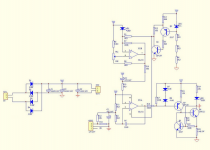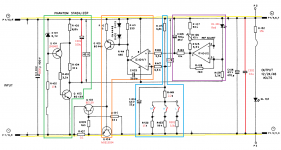How long have you run the Rpi continuously without any problem?
Im thinking to attach the MJE15034 to this heatsink as it can be placed in a cut-out casing.
120x69x27mm Koeling Aluminium Koellichaam Module Grille Vorm Koeler Radiator Zwart Oxide Cooling Fin Heatsink voor IC LED Power|Ventilatoren en koeling| - AliExpress
Im thinking to attach the MJE15034 to this heatsink as it can be placed in a cut-out casing.
120x69x27mm Koeling Aluminium Koellichaam Module Grille Vorm Koeler Radiator Zwart Oxide Cooling Fin Heatsink voor IC LED Power|Ventilatoren en koeling| - AliExpress
If you connect the 2 x 9Vac secondaries in series you will have an 18Vac supply that you could connect to one side of the Studer900 clone board. That would allow the board to produce the 16Vdc that you require.
An 18Vac input will produce about 24Vdc at the smoothing caps so your regulator will need to lose about 8V in producing the 16V output you require. At 1 amp the heatsink will need to dissipate about 8W. You will need to make sure that your heatsinking can handle that and, if not, upgrade your solution with a larger heatsink or perhaps mount the heatsink onto the case.
With this scenario one side of your Studer900 clone board will remain unused.
Hope this helps.
So, it turns out I did exactly this. The 2 x 12V trans that my dad offered me was huge (300VA or something) so I opted to just use one side of the board with the 2 x 18
Thanks to all of your excellent advice, I t works, which is a big relief (and I’m pretty chuffed about that, too). The heat sink does get very hot, though. Would you recommend, as MrHiFiTunes suggested, to parallel the dual boards or just use a better heat sink or the case to deal with it.
The other question I had is that only one of the LEDs light up (the one next to the big cap), should they both light or is the 2nd one an overload alert or something?
Thanks
Without a schematic it's tricky to work out what its function is, if any, beyond being a visual indicator that the board is working. My guess would be that it is just an indicator or possibly that it also provides a small load for running down the charge on the board's capacitors.
You could try moving your supply and load connections to the other side of the board and seeing whether both LEDs light up on that side (don't forget to set the voltage). If they do then it's probably odds on that the LED has simply failed and you could replace it or just shrug and continue to use the fully working side.
Note that the heatsinks are currently grounded. If you move them off the board you should ensure that they continue to be.
You could try moving your supply and load connections to the other side of the board and seeing whether both LEDs light up on that side (don't forget to set the voltage). If they do then it's probably odds on that the LED has simply failed and you could replace it or just shrug and continue to use the fully working side.
Note that the heatsinks are currently grounded. If you move them off the board you should ensure that they continue to be.
Without a schematic it's tricky to work out what its function is, if any, beyond being a visual indicator that the board is working. My guess would be that it is just an indicator or possibly that it also provides a small load for running down the charge on the board's capacitors.
You could try moving your supply and load connections to the other side of the board and seeing whether both LEDs light up on that side (don't forget to set the voltage). If they do then it's probably odds on that the LED has simply failed and you could replace it or just shrug and continue to use the fully working side.
Note that the heatsinks are currently grounded. If you move them off the board you should ensure that they continue to be.
I swapped to the other side of the board and both leds work and the heatsink doesn’t seem to be getting as hot as it was. I think I read here that the transistor operates fine up to 110 deg and i guess if I can hold it a few seconds before it gets uncomfortable then its probably nowhere near that. I’ll troubleshoot the other side further if I have occasion to use it.
By the way, considering that we’re on an audio forum after all I should add that the Aries mini sounds substantially better running off the studer900 than it does off the wall wart it ships with. The noise floor is lower and voices and instruments have much more convincing bodies in space. I’m very pleased with the difference. Plus I’ve got the smps running off a power filter and the LPS isn’t yet so I expect it will get better still.
Next step is to make a case to put it in. I couldn’t find any I liked that were the right size but weren’t horrendously expensive, so I’m going to make one from scratch. I’ll post some pics here when I’m done.
Thank you all again for your generous advice. I raise my cup of tea to you
Studer 900 powering Pi 4 with right heat sink method ok for me
I've run the Pi 4 for hours with the setup with no issues. (Assume you were talking to me).
I have yet to set up the Arduino-based heat sink temperature monitoring but may do so this weekend, at which point I'll post findings.
How long have you run the Rpi continuously without any problem?
Im thinking to attach the MJE15034 to this heatsink as it can be placed in a cut-out casing.
120x69x27mm Koeling Aluminium Koellichaam Module Grille Vorm Koeler Radiator Zwart Oxide Cooling Fin Heatsink voor IC LED Power|Ventilatoren en koeling| - AliExpress
I've run the Pi 4 for hours with the setup with no issues. (Assume you were talking to me).
I have yet to set up the Arduino-based heat sink temperature monitoring but may do so this weekend, at which point I'll post findings.
@JCMcNeilI've run the Pi 4 for hours with the setup with no issues. (Assume you were talking to me).
I have yet to set up the Arduino-based heat sink temperature monitoring but may do so this weekend, at which point I'll post findings.
I will try to add extra cooler too. I came across this one which i ordered.
SSR Aluminium Koellichaam 25A 30A Zilver Tone Solid State Relais HeatSink Radiator voor Eenfase SR W|Relais| - AliExpress
I hope it give me the possibility to fix it too the case. Seems it can be fixed both ways (coolingfins inside the case or outside).
Hope its good enough to keep things cool.
Since I have 9V AC iso 12VAC, I assume it needs to dissipate less.
How is the Arduino based head sink monitoring project going?
Modding AURALiC Aries Mini
It really needs better convection. Adding a fan is not the right thing for that.
It really needs better convection. Adding a fan is not the right thing for that.
- Home
- Amplifiers
- Power Supplies
- low noise Pre-Amp / DAC power supply MJE15034 TL072 Regulator based on STUDER 900




